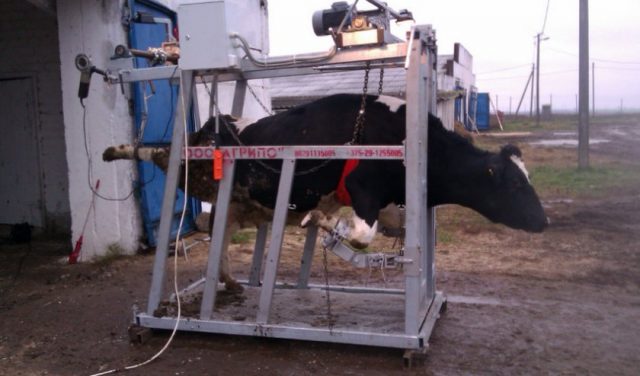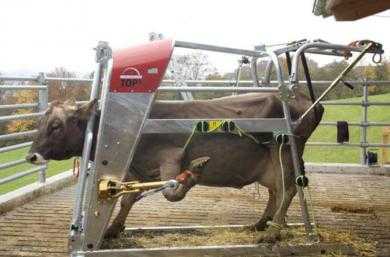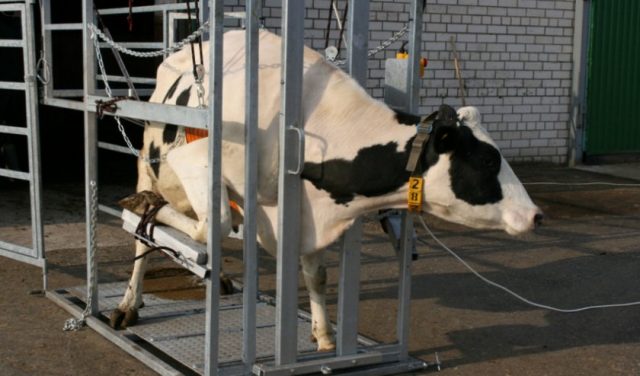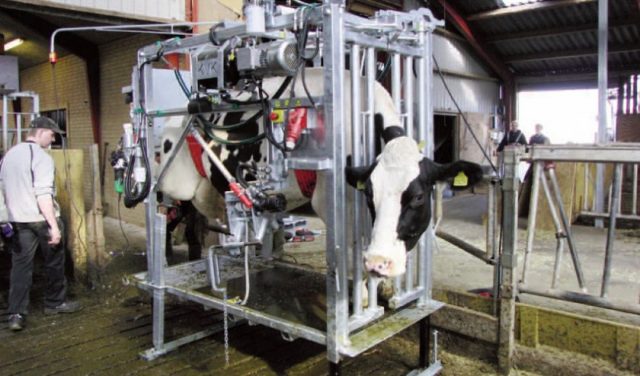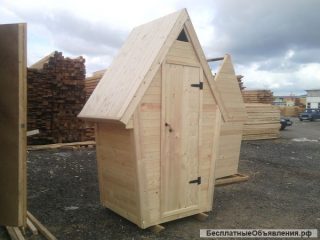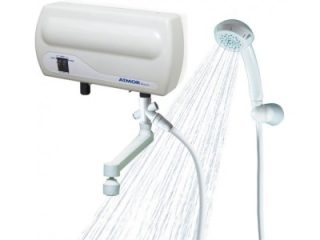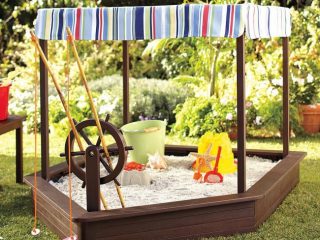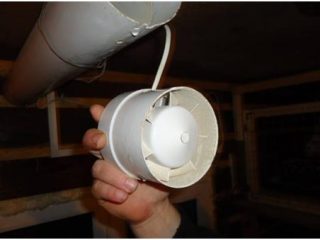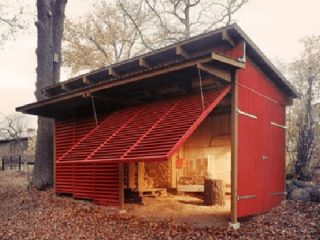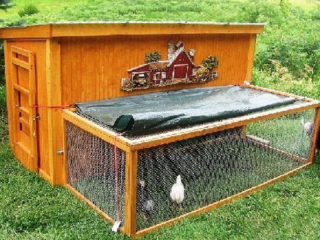Content
A machine for processing cattle hooves is a device in the form of a metal frame or box with a mechanism that limits the activity of the animal. A factory-made product is expensive. In order to save money, livestock farmers make splits themselves. Machines are used not only for processing hooves. The device helps to carry out examinations and treatment of cows.
What types of machines are there for fixing cattle?
Cattle machines from different manufacturers differ in design features. Regardless of the manufacturing technology used, all splits function according to the same principle and are placed inside the barn. Hoof trimming machines are:
- collapsible;
- easel;
- mechanical;
- with electric drive for front and rear legs;
- hydraulic;
- wheeled.
The last option is convenient in terms of movement. The machine is convenient to roll due to the presence of powerful wheels.
Almost all factory-made machines are a rectangular structure made of metal frames. Approximate dimensions:
- length – 2.5 m;
- width – 1.1 m;
- height – 2 m.
A device for processing hooves is made of metal. The protective coating is a galvanized layer or paint.The machine does not have sharp corners or protrusions that could injure the animal during the procedure. The locking mechanism is chains with leather straps.
They tell you more about the machines in the video
Pros and cons of cattle hoof machines
According to the rules of cattle veterinary medicine, hoof treatment is a mandatory measure aimed at improving animal health. Without machines it is impossible to perform the procedure, and this is their main advantage. Other advantages include:
- Most machines are compact and have transport wheels;
- a convenient fixation mechanism does not compress the internal organs of the animal during hoof trimming;
- the split simplifies the procedure without exposing the cow to stress and protects the operator from being hit by hooves;
- machines help perform other veterinary activities: horn trimming, examination, medical care;
- the split allows one person to perform the hoof trimming procedure;
- One machine can serve up to 100 animals per day.
Disadvantages are observed in the design of some models:
- a light split with poor support is unstable and may tip over during hoof trimming, resulting in injury to the cow and the operator;
- Due to incorrectly positioned belts, poor fixation occurs and the animal experiences discomfort.
However, shortcomings are usually observed in homemade designs and cheap machines of unknown origin.
In a good pen, the animal behaves calmly due to the presence of comfortable support. It is optimal to give preference to vertical models, since lateral fixation is dangerous for pregnant cows. In a high-quality split, the support is located at the same level with the floor. High descent is not allowed. The cow slips on it, falls, and gets injured.
How to choose the right machine
In order to optimally select the right split for cattle, you first need to find the exact answer to a number of questions:
- For how many livestock is the device designed?
- How many cows need to be processed per day?
- How many operators?
- The machine will be used to service beef and dairy cows or a universal model is needed.
- Splitting is only necessary for hoof trimming or other procedures.
- Which type of machine is more suitable: mechanical, hydraulic, on wheels, with electric drive.
- How much money is the owner willing to invest to buy a split?
- Is the owner ready to incur high costs for the purchase of a device that provides increased safety for cattle and the operator and comfortable working conditions?
Having found the answers to the questions, choosing a model will be significantly simplified.
Rules for processing cattle hooves
The hard stratum corneum protects the animal's hooves from damage. However, over time it develops into thick growths. If the stratum corneum is not cut off in time, the cow begins to experience pain while walking. The animal limps and falls.
The basic rules for hoof trimming are:
- The first procedure is performed under the guidance of an experienced specialist.
- The frequency of pruning is determined by the method of maintenance: stall - three times a year, free-stall - twice a year.
- The day before the procedure, the cattle are kept on damp bedding. Moisture makes the stratum corneum of the hooves softer.
- The instrument is disinfected.
- After restraining the cow, make sure that she is comfortable. Check the tightness of the belts.If the cow is agitated, it is recommended to inject a sedative.
- On the day of the procedure, cattle are provided with peace and quiet. Loud exclamations and noise will cause stress.
- Before trimming, the hooves are washed from dirt, treated with an antiseptic solution, and checked for inflammation.
- Trimming the stratum corneum is carried out carefully so as not to damage the hooves. Grind down the protruding sharp edges.
Before servicing cattle begins, the animal must be driven into the pen. The best option is to install it opposite the entrance doors of the barn. The animal will calmly enter the pen. They close the door behind the cow and begin securing body parts with straps. The head should fall into a special recess.
In private farmsteads, a stationary machine is usually located where there is space. The owner leads the cow out of the barn on a leash and calmly leads it to the place of the procedure. The animal is calmed down with gentle persuasion.
The sequence for trimming cattle hooves consists of the following steps:
- The driven animal into the split is securely secured with straps. They clean, inspect the hooves, and take measurements.
- The front legs of cattle are cleaned first. The cut is made carefully, moving along the hoof. Remove all gray growth until a white, hard surface appears.
- Stepping back from the edge of the sole about 3 mm, place the forceps. The device will help to clean the surface to the same thickness using a cutter.
- Protruding wool bristles are cut off with scissors. Sharp protrusions are processed with a file. The hoof is considered properly cleaned if the sole rests flat on a flat surface, such as a knife blade.
After trimming, the hooves are disinfected.The new surface is susceptible to infections. To protect the white layer, smear it with a solution of copper sulfate or use a strong agent - formaldehyde, then wash it with water pressure.
How to make a machine for processing cattle hooves with your own hands
Factory-made machines are expensive. It is not profitable for an owner who owns 1-3 cows to buy them. The device is made independently. A durable structure can be obtained if it is welded from metal pipes. A device assembled from wooden posts and boards will serve as a temporary split.
Tools you will need:
- wood hacksaw;
- Boer;
- screwdriver;
- hammer.
To fix wooden elements, nails and screws are prepared.
Assembly of the structure:
- 4 pillars 1.7 m long and 2 pillars 0.7 m long are sawn off from round timber or wooden beams.
- The location of the poles is marked on the site. The holes are drilled with a drill.
- Long pillars are placed along the contour of the quadrangle. They form the basis of the structure. Small pillars are placed along the edge. The cattle's legs will be fixed to them. Small pillars are removed from the base of the quadrangle by about 0.5 m. The depth of immersion in the ground of all supports is 0.2 m.
- Boards are sewn onto the installed pillars. On both sides below, spacers are nailed crosswise to prevent the structure from loosening. A cross member is attached to two small supports.
A chain to hold the animal and securing straps during trimming are placed on the poles of a homemade machine.
Conclusion
A machine for processing cattle hooves must be reliable.If you decide to make it yourself, then it is advisable to give preference to a steel structure, but it will cost more than its wooden counterpart.

